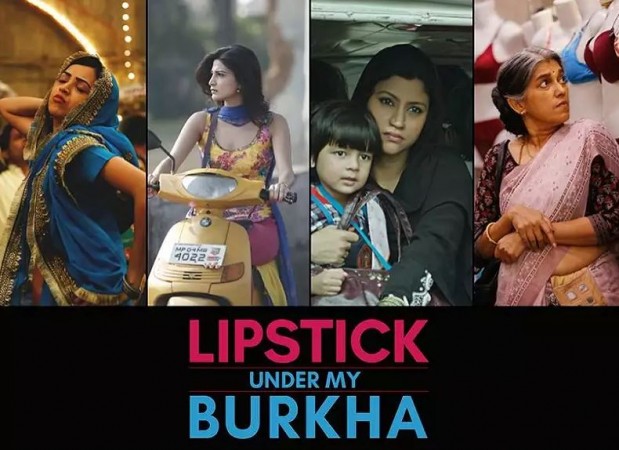
A significant controversy erupted in the Indian film industry at the beginning of April 2017 when the Central Board of Film Certification (CBFC) declined to certify the movie "Lipstick Under My Burkha." The board's decision to reject certification was largely motivated by their assessment of the movie as being "lady oriented," which sparked a contentious discussion on censorship, gender bias, and artistic freedom in the nation. The ban's genesis, justifications, and wider ramifications for both the film industry and society at large are all explored in this article.
An Indian movie called "Lipstick Under My Burkha" was produced by Prakash Jha and directed by Alankrita Shrivastava. The story of four women from various backgrounds who all reside in the same conservative small town is intertwined throughout the movie. It investigates their tribulations, longings, and ambitions—often veiled and kept a secret. Even the title of the movie represents the idea of women embracing their identities and desires despite social pressures.
"Lipstick Under My Burkha"'s controversy started when the CBFC, also known as the censor board, declined to accredit the movie. This denial effectively forbade the film's public screenings, commercial releases, and distribution in India. The film's "lady oriented" content, which the board deemed to be too explicit and contrary to Indian culture and values, was one of several factors cited by the board as justification for their decision.
The term "lady oriented" used by the CBFC immediately sparked debate over its appropriateness and potential for gender bias. The term, according to critics, was ambiguous and left room for interpretation, allowing the board to arbitrarily censor material they deemed inappropriate. Many people were concerned about this ambiguity because it could potentially be used to stifle narratives that empower women or examine female sexuality.
The outlawing of "Lipstick Under My Burkha" sparked a larger discussion about discrimination against women in the Indian film industry. Many critics and filmmakers claimed that the CBFC was employing a double standard by censoring material that focused on the perspectives of women while allowing similarly explicit material with male-centric narratives. This raised concerns about the board's contribution to the maintenance of patriarchal norms.
Significant questions about artistic freedom in India were also raised by the decision to ban the movie. Censorship, according to filmmakers and artists, should be restricted to matters of public safety and should not be used to stifle artistic expression or the investigation of social issues. They argued that films like 'Lipstick Under My Burkha' were essential in bringing attention to women's issues and serving as a forum for discussion.
Widespread public outcry and support for the movie and its producers followed the CBFC's decision to outlaw "Lipstick Under My Burkha". Many people expressed their support for the filmmakers and denounced the censor board's decision, including well-known actors, directors, and social activists. Indicating the public's anger at censorship, social media platforms were inundated with hashtags like #LipstickRebellion and #StandWithLipstick.
The creators of "Lipstick Under My Burkha" made the decision to appeal the CBFC's ruling in court in the midst of the uproar. The directors claimed that the board's choice was arbitrary and infringed on their right to free expression. The film was finally given a "A" certificate by the Film Certification Appellate Tribunal (FCAT) in February 2017 after a protracted legal battle, allowing it to be viewed by adults.
The legal dispute that followed the decision to forbid the release of "Lipstick Under My Burkha" had a number of important repercussions for the Indian film industry and society at large.
The debate highlighted the demand for more inclusive and diverse representations of women in Indian cinema. It contested the conventional narratives that frequently portray women as apathetic or servile. The achievement of certification for "Lipstick Under My Burkha" demonstrated the rising demand for complex depictions of female characters and their experiences.
On the topic of censorship in Indian cinema, the ban sparked discussions. It sparked debates about whether the CBFC should continue to serve as a moral policeman, particularly in a society that is changing and in which attitudes towards sexuality and gender roles are changing. Others demanded a total rewrite of the censorship system, while some argued for a more lenient approach.
In India, women filmmakers used the controversy as a point of inspiration. As a result, they were inspired to tell tales from their own points of view and abandon the stereotypical male viewpoint that has dominated Indian cinema for so long. The film "Lipstick Under My Burkha" paved the way for additional works focused on women and exploring issues of sexuality, identity, and empowerment.
The CBFC's decision to ban "Lipstick Under My Burkha" in April 2017 was a turning point in Indian cinema. It brought to light issues of gender bias, censorship, and the requirement for more creative freedom. In a society that is significantly changing its attitudes towards gender and sexuality, the eventual certification of the film served as a reminder of the value of telling diverse stories and giving women's voices a platform. The controversy initially set the movie back, but it ultimately served as a starting point for significant discussions and adjustments in the Indian film industry.
Ayushman Khurrana's Voice Mastery in 'Dream Girl'
In 'Dream Girl' (2019), Anu Kapoor Pays Homage to Hema Malini's Dream Girl Persona
Deccan College's Historical Grandeur Sets the Stage for 'Haseena Parkar's' Pivotal Scene